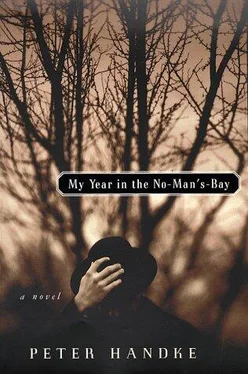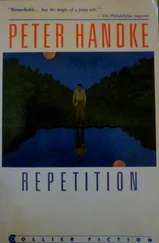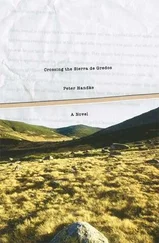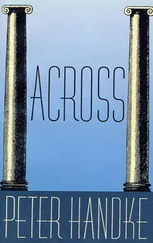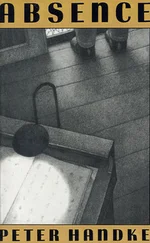To be sure, he had already erected a doorframe made of the same weather-resistant wood as the staircase, broad like a portal, set into a marble base, but it stood, and apparently not only temporarily, somewhere else entirely on the lot, with nothing else around it, and seemed to belong to a second house or a future courtyard wall; and the ramp of tamped red earth, located somewhere else again, gently mounting into nowhere, was perhaps conceived of as the approach to a barn, or at least such a thought was suggested by the ladder wagon left from his parents’ days that stood there, with stone chucks behind the wheels, the shafts stretched forward as if in anticipation of a new draft animal — though he then put the barn somewhere else entirely, at first nothing but four tall poles set in concrete, topped by the ridgepole and the rafters, uncovered to this day, through all of which the air whistled, except in the entryway built down below, its boards tightly joined, with two completed doors and even a glazed and puttied window, an entryway large enough to sit in — but what did that have to do with a barn?
A trench from the First World War ran right through the builder’s work area; his parents had filled it with rock and especially brush when they cleared the land, and he piled more on top of the juniper, grapevine roots, blackberry bushes, interwove the whole thing, stuffed the interstices with the tough savanna grass, the hard, clumpy red earth, smoothed and rounded the top, creating, along the former trench, the longest, most curving, most elastic bench for sitting on that I have ever encountered, although it was not certain that this structure had been planned as such: would he raise the bench later to the height of a wall, perhaps even studding the top with bottle shards?
At first sight someone might perhaps have mistaken all his piecework for a movie set. But for that the individual elements were too solid. A set designer or builder would never have been capable of designing and devising actually usable nooks like the craftsman and master here. And in distinction to a movie set, with these structures the adventure being played out or the relevant story would remain utterly mysterious, or, on the contrary, would not pose the slightest mystery.
His architectural works outside of the inherited parcel, in hidden no-man’s — lands in the four corners of the globe, stood there unnoticed. Aside from his friends, hardly anyone knew that those mounds that could easily be confused with local piles of rubble and soot were, under their camouflage, bake ovens, cisterns, root cellars, and woodsheds.
This notion stemmed from his childhood on the karst, in a borderland, which additionally had the “Communist threat” on the other side of the border, against which a third of the entire Italian army was massed, with weapons and tanks, all camouflaged under fake woodpiles, from which, when he was on his way to school, he would suddenly see a tank’s gun thrusting, under fake igloos of stone, which would unexpectedly flip open, revealing the nose of a rocket, inside a lone tree of the steppe, from which, through a sliding door, a heavily armed guard would emerge: the architect and carpenter’s later structures were the reverse of all this.
The only money he earned, in addition to that from odd jobs, came from a position at the University of Udine, where, for one hour per week, he taught the architecture of Greece and Rome, and his earnings went almost entirely on his building projects, or, as he called them, “void building,” “memory building,” “attention building.” That he could spend this year in Japan was a birthday present from us, all his friends, and to reciprocate he had promised us a sort of photograph album, with the working title “No-Man’s-Land Strips in Japan.”
Yet up to now, the middle of autumn, he had hardly taken a picture, although the painter had given him a camera that could take pictures with the most accurate long-distance focus, and although, contrary to expectation, here and there among the Japanese subdivisions, which were built up almost solidly, something similar to terrain vague had turned up; he had hardly taken a picture either of the theme of his journey or of anything else typically Far Eastern, but instead perhaps a picture of a motorbike wrapped in a silvery tarpaulin in Yokohama, the hands of three children, one on top of the other, on an umbrella handle on the tiny island of Izu, a wooden rack for drying rice straw, similar to the hayracks in Carinthia and Slovenia, at the turnaround in a field in the north — and that could have been anywhere in the world.
The moment was gradually approaching for fulfilling his promise. But, as he just wrote to me, he still feels reluctant to take pictures. And the photograph he did send along, of the Ryoanshi Temple, which he had just visited for the second time, of the “nothingness” or contentlessness of Kyoto, did not show the famous empty pebble garden with mossy boulders (and in addition perhaps the rake belonging to the monk-gardener), but, as a wobbly snapshot, merely the masses of visitors, sitting head by head on the balustrade around the square, their legs dangling down, apparently talking loudly, laughing, squinting as they faced the expanse of nothingness.
The handwriting in the architect’s letter was certainly not that of a person who had been sitting idle. It was that carpenter’s writing that I take as my model now and then. By that I do not mean the thickness of the carpenter’s pencil, intended for marking and numbering pieces of lumber, but rather the heaviness of the hand, perceptible to the reader, from which I sense: the man who wrote that must have been working just beforehand, using his entire body.
Not that the writing is shaky. Rather, it is rounded, the fingers, just washed, rest on the paper, except the index finger and the thumb, blood coursing through them from the manual labor in which he was just engaged, and the joints follow accordingly, and with them the lines, loops, connections, and transitions among the individual letters. The carpenter’s writing has something about it as handy as it is hearty, it is painted and built, and it breathes like the thing written; I decipher it as a document.
Thus I have likewise developed the habit of seeking out some physical work that involves the whole man — not a sport — before I get down to writing. Except that my raking, sawing, chopping, cropping, thinning is different from the carpenter’s painstaking fitting, joining, measuring, nailing, bracing, and more often than not I fail to achieve with my gardening that pulse of variety that would make my hand not only heavy but also flexible.
And as I look again at my distant friend’s letter, I picture him that same morning, on a vacant lot in Kyoto, onto which, overgrown as it is, he fought his way with the help of a bamboo knife, and where he has gathered and piled up stones to make a hidden fireplace, from the outside merely the empty base on which at one time, in the outer courtyard of a now vanished holy place, the demon of deterrence once stood. For secretly the architect has an entirely different project in mind than the aforementioned photo album: to leave behind in a Japanese no-man’s-land another such camouflaged structure.
Back there in the winter snow of Morioka he was already close to accomplishing it. After weeks of searching from south to north, he was standing, not all that far from the center of town, at the first break in the rows of houses that otherwise stretched unbroken across the long island country of Japan.
The sight of the windy strip, with nothing but a clump of bamboo poking tall and narrow out of a puddle frozen solid, down to the gravel at its bottom, without a sign that new building activity was in the offing, for the moment did him nothing but good. A very long time ago something must have been built in this opening, of which now only a certain artificial unevenness, its forms blurred, served as a reminder. The wire fence that separated it from the street had gaps where one could slip through; it had rusted out long ago, and no sign either indicated that the place prohibited entry or announced new construction. From the crown of the bamboo, whose shafts were bluish, came a seething and humming, and the listener wished the sound would resolve itself into an utterance that he could take away with him.
Читать дальше
